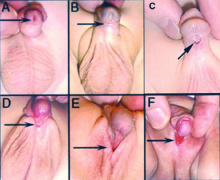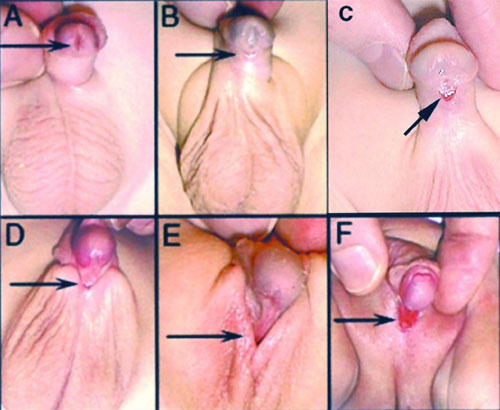File:Hypospadia classifications.jpg
Hypospadia_classifications.jpg (500 × 410 pixels, file size: 47 KB, MIME type: image/jpeg)
Classification of Hypospadias
Hypospadia is classified by the location of the opening (meatus).
A Anterior - on inferior surface of glans penis.
B Coronal - in balanopenile furrow.
C Distal - on distal third of shaft.
D Penoscrotal - at base of shaft in front of scrotum.
E Scrotal - on scrotum or between the genital swellings.
F Perineal - behind scrotum or genital swellings.
Hypospadias most common penis abnormality (1 in 300) from a failure of male urogenital folds to fuse in various regions and resulting in a proximally displaced urethral meatus. The cause is unknown, but suggested to involve many factors either indivdually or in combination including: familial inheritance, low birth weight, assisted reproductive technology, advanced maternal age, paternal subfertility and endocrine-disrupting chemicals. Infants with hypospadias should not undergo circumcision.
| Classification | ICD-11 | Meatus Opening | Image | 
|
|---|---|---|---|---|
| Anterior | glandular | urinary meatus that opens at the site of the frenulum | A | |
| Coronal | coronal | urinary meatus opens in the ventral portion of the coronal sulcus | B | |
| Distal | penile | urinary meatus that opens along the shaft of the penis | C | |
| Penoscrotal | penoscrotal | urinary meatus opens where the shaft of the penis meets the scrotum | D | |
| Scrotal | scrotal | urinary meatus that opens on the scrotum | E | |
| Perineal | perineal | urinary meatus that opens in the perineum | F | |
| Table reference[1] Links: hypospadias | 'ICD-11 Hypospadias | ||||
Surgical Repair
Depending on the class of hypospadias there are a number of different surgical repair techniques including: orthoplasty or penile straightening, urethroplasty, meatoplasty and glanuloplasty, scrotoplasty and skin coverage.
Image Source: Baskin etal, 2001[1]
- Links: Hypospadia | Genital System - Abnormalities
References
Cite this page: Hill, M.A. (2024, April 18) Embryology Hypospadia classifications.jpg. Retrieved from https://embryology.med.unsw.edu.au/embryology/index.php/File:Hypospadia_classifications.jpg
- © Dr Mark Hill 2024, UNSW Embryology ISBN: 978 0 7334 2609 4 - UNSW CRICOS Provider Code No. 00098G
Copyright: Reproduced with permission from Environmental Health Perspectives (EHP) is a publication of the U.S. Government. Publication of EHP lies in the public domain and is therefore without copyright.
File history
Click on a date/time to view the file as it appeared at that time.
| Date/Time | Thumbnail | Dimensions | User | Comment | |
|---|---|---|---|---|---|
| current | 11:23, 26 January 2010 |  | 500 × 410 (47 KB) | S8600021 (talk | contribs) | Classification of Hypospadias Hypospadia is classified by the location of the opening (meatus). A Anterior - on inferior surface of glans penis. B Coronal - in balanopenile furrow. C Distal - on distal third of shaft. D Penoscrotal - at base of shaf |
You cannot overwrite this file.
File usage
The following 31 pages use this file:
- 2010 BGD Practical 12 - Abnormalities
- 2010 BGD Tutorial - Applied Embryology and Teratology
- 2010 Lecture 1
- 2011 Lab 12 - Abnormalities
- 2011 Lab 8 - Genital Abnormalities
- 2014 Group Project 9
- ANAT2341 Lab 12 - Abnormalities
- ANAT2341 Lab 8 - Genital Abnormalities
- Abnormal Development - Australian Statistics
- BGDA Practical 12 - Abnormalities
- BGDB Sexual Differentiation - Abnormalities
- BGD Lecture - Face and Ear Development
- BGD Lecture - Sexual Differentiation
- BGD Tutorial - Applied Embryology and Teratology
- Genital Abnormality - Hypospadias
- Genital System - Abnormalities
- Lecture - 2011 Course Introduction
- Lecture - 2012 Course Introduction
- Lecture - 2013 Course Introduction
- Lecture - 2014 Course Introduction
- Lecture - 2015 Course Introduction
- Lecture - 2016 Course Introduction
- Lecture - 2017 Course Introduction
- Lecture - Genital Development
- Maternal-Fetal Medicine Trainees - Renal
- Talk:2010 BGD Tutorial - Applied Embryology and Teratology
- Talk:Lecture - 2016 Course Introduction
- Talk:Lecture - Renal Development
- File:Hypospadia classifications.jpg
- Template:Hypospadias Classification Table
- Template:Victoria abnormal data table 2004
